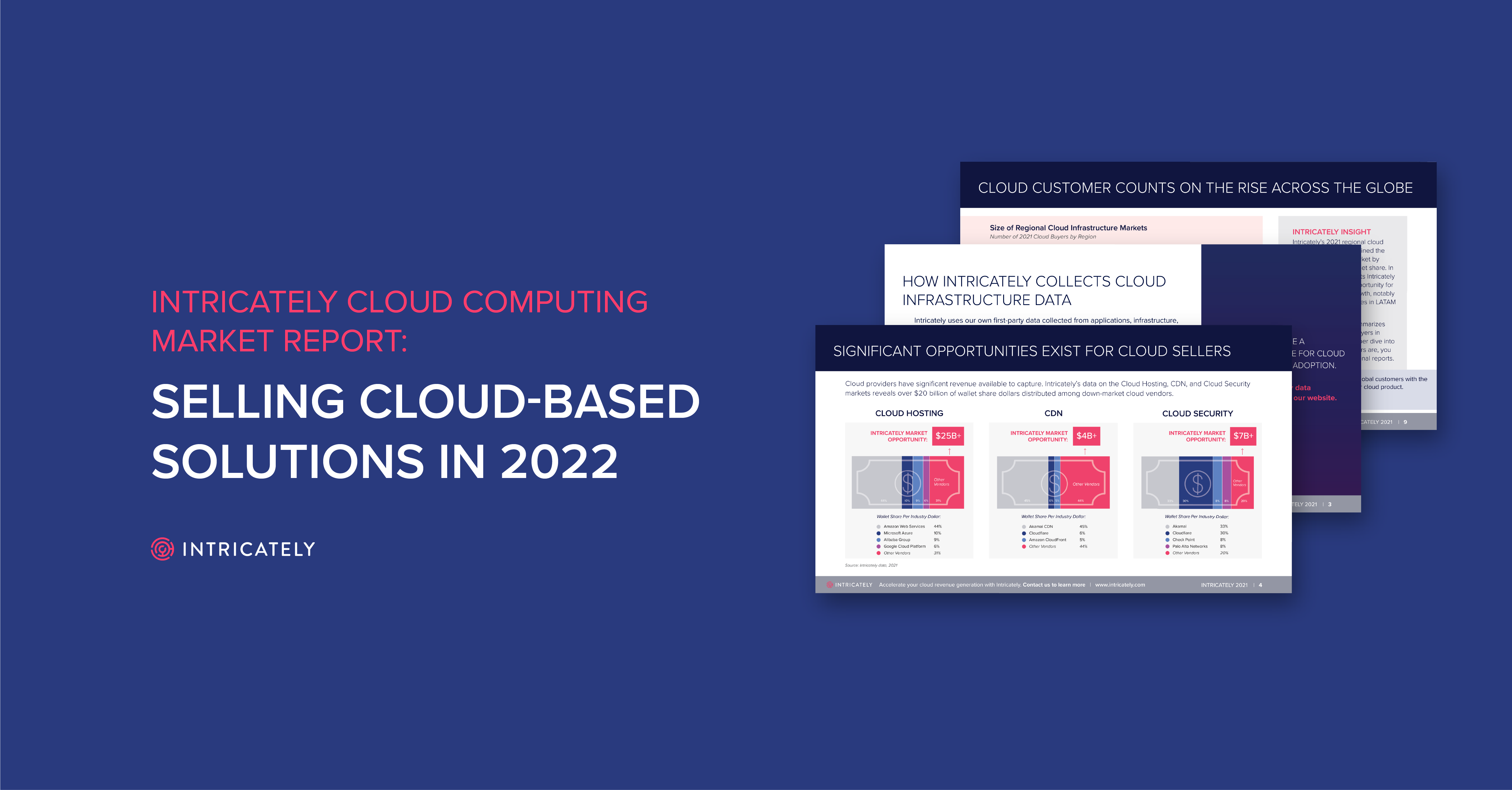
 back to all posts
back to all posts
Revenue Isn’t The Whole Picture: Cloud-Native Metrics In A Cloud-Centric World [Webinar Recap]

Cloud-native metrics give sales and marketing teams a granular view into how target accounts are using and expanding their cloud environment. Intricately recently partnered with the International Data Corporation (IDC) to combine their qualitative market research with the usage metrics that Intricately provides.
IDC provides global companies with in-depth insight based on everything from financial models to large scale surveys and interviews. For the past decade, IDC has been applying these approaches to the cloud market. But what if the analysts at IDC could broaden their view of the market with hard numbers on traffic and cloud usage?
That’s exactly the topic two IDC analysts tackled in a recent webinar. To give a practical view into how Intricately data can inform IDC market research, the market research experts provided an overview of both Content Delivery Network (CDN) and cloud markets.
These are the main takeaways. Ready to jump in?
Intricately-IDC Partnership: What We Brought to the Table
IDC is a global provider of market intelligence and advisory services for the IT, telecom and consumer tech markets. The firm’s services help “IT professionals, business executives and the investment community to make fact-based technology decisions and to achieve their key business objections.”
Kuba Stolarski and Deepak Mohan are Research Directors for IDC’s Infrastructure Systems, Platforms and Technologies group. They are both tasked with overseeing the forecasting process for cloud and IT infrastructure.
Typically, IDC’s research activity falls in to one of three distinct buckets: supply chain, revenue and cloud usage based on more qualitative data.

IDC draws upon vendor guidance, financial models and feedback from research panels, surveys, interviews, inquiry, and supply chain channels.
But what if there was a way to enrich these insights with more granular data? Stolarski and Mohan presented several iterations of this question in the webinar. What if:
- You could eliminate opinion and confusion?
- You could check on usage everyday?
- You could track what companies are doing in the cloud?
“If you could do these things, you’re most likely a company called Intricately,” Stolarski said. “We were intrigued byIntricately’s enormous data set. We wanted to see how our own views of customer usage could be shaped by the data generated by Intricately.”
Intricately has comprehensive data on the adoption and usage of cloud infrastructure.

Intricately’s Global Sensor Network monitors and reports on digital product usage and spend behavior for more than 7 million businesses worldwide. Cloud vendors rely on Intricately to inform and accelerate their forecasting and sales execution.
IDC partnered with Intricately to see how IDC research could be complemented by the digital data generated by Intricately.Specifically, the IDC team wanted to address two questions:
- What is the intersection of cloud and CDN?
- To what extent are companies employing a multi-cloud strategy?
CDN Usage Highlights: Customers vs. Traffic
Made up of proxy servers and data centers, CDNs are critical infrastructure for companies with a distributed workforce.
In 2018, CDN services revenue was $5.9 billion. It’s not as large of a market as IaaS, but CDN adoption is still growing. Some of the ‘big’ names (by recognition, not necessarily usage) are Akamai, CenturyLink and Fastly.
Which platform sees the highest usage?

At first blush, it seems Cloudflare is the biggest CDN by a large margin. Even after breaking out the numbers based on company size (‘larger’ and ‘smaller’), Cloudflare is a top contender rivaled only by Amazon CloudFront.

But basing size by the number of customers a platform has may not be the most accurate to determine the ‘top’ platform. Cloudflare has the highest number of customers by far — but does that mean they receive the most traffic?

In terms of traffic value, Cloudflare moves to the back of the pack compared to the traffic that Amazon CloudFront, Akamai and Fastly receive.
Cloudflare has more customers, but clearly Amazon and Akamai see much more traffic both from larger and smaller companies. Fastly sees a big boost for smaller companies as well.
Amazon and Akamai customers are heavy users compared to Cloudflare’s customers. Heavy usage also lends to overlap; nearly a third of AWS customers are also Amazon CloudFront customers. In contrast, less than ten percent of Microsoft Azure customers also use Azure CDN.
A simple revenue view of the market is far from comprehensive; accounting for traffic values and overlap gives a more granular view of the market.
That’s the breakdown for CDN usage and the overlap with cloud solutions. But what does cloud usage for these company sizes look like?
Cloud Usage Highlights: Multi-Cloud is the Norm
If we’ve learned one thing from the past decade of enterprise cloud providers’ rapid expansion, it’s that cloud infrastructure is not a passing fad.
Enterprise adoption is accelerating public cloud infrastructure usage growth, and companies of all shapes and sizes are using cloud, hybrid cloud and multi-cloud solutions. Public cloud IaaS revenue will hit close to $70B this year. Revenue will eclipse traditional cloud infrastructure (with over $100B in revenue) by 2022.

In the early stages, new cloud technology was embraced by startup apps, disaster recovery companies, and early adopters in enterprise IT. Now, growth is driven by SaaS expansion, digital transformation initiatives at the enterprise level, and broad adoption within enterprise IT.
Today, cloud infrastructure has broad adoption by enterprise IT teams, including for use cases within business critical applications and data. But what does actual usage look like?
Two cloud solutions in particular are the unquestionable kings of the cloud. AWS and Azure account for around half of all customer spending on applications deployed to public cloud. The top five providers make up just over 60 percent altogether — which means AWS andAzure take the lion’s share of the market within these top five providers.

AWS and Azure may dominate the market, but they don’t own it wholesale. Use case and segment specific differences mean that the rest of the market continues to see growth. More than that, the market shares within the top five providers are also in a constant state of flux.
We see this dominance from the company side as well. Among larger companies, nearly 80 percent use AWS and nearly 50 percent use Azure. For smaller companies, the respective numbers are around 70 percent and 30 percent. Less than 10 percent of companies use neither provider.

Multi-cloud accounts for the overlapping percentages.
Initially, the use of multiple public cloud IaaS providers by customers was incidental rather than strategic — the enterprise IT team started using multi-cloud as the need arose.
But multi-cloud is now emerging as a more intentional, strategic course of action. Customers are using multiple clouds for targeted use cases, disaster recovery configurations and for regional reach.

The majority of companies took a multi-cloud approach in both 2018 and 2019.Last year, over 60 percent of companies used multiple public cloud IaaS providers.
Company size also affects multi-cloud usage.
Among the two company sizes in consideration, multi-cloud usage was lower than the aggregate. Around 35 percent of larger companies use multiple cloud solutions, and just 20 percent of smaller companies are multi-cloud users.

More granularly, Azure customers were more likely to use AWS than the other way around. Utilizing a third IaaS provider is not common (less than 5 percent of companies use a third provider).
Use of hybrid cloud architectures was also up in 2019 — just over 50 percent of companies used both on-prem and cloud infrastructure in 2019. It’s a big jump considering just around 35 percent of companies used hybrid cloud in 2018.
Unsurprisingly, companies with a multi-cloud approach (using both AWS and Azure) were the most likely to use a hybrid cloud architecture. Nearly 70 percent of larger companies and just over 50 percent of smaller companies have a hybrid solution.
This suggests that companies with a multi-cloud strategy are using a more mature approach to cloud infrastructure.
What’s Next?
IDC will continue with the proven model of surveys, focus groups and engagements (and explore the opportunity to gather data from APIs).
To provide both depth and breadth to the research they provide their customers, IDC’s research teams will continue to use Intricately data. IDC will be able to combine data points from Intricately to complement other, more qualitative insights into use cases and demand across regions and providers. Data presented in the webinar is from IDC andIntricately sources.
As Stolarski and Mohan pointed out at the end of the webinar, the two market research approaches should not be mutually exclusive. Instead, they are designed to supplement each other. Qualitative data from surveys and panels is critical for depth, and Intricately data is critical for real-time understanding of cloud usage.
Intricately looks forward to extended and new partnerships to bring measured digital metrics into IDC’s data models.

3 Trends Shaping the Evolving Cloud Hosting Market

4 Ways Cloud Marketing Leaders Can Get the Most From Their Budgets in 2022

How to Perform Account Segmentation and Prioritization



Introducing Intricately's 2022 Cloud Infrastructure Market Report


Intricately’s Cloud Computing Market Report: Selling Cloud-Based Solutions in 2022


